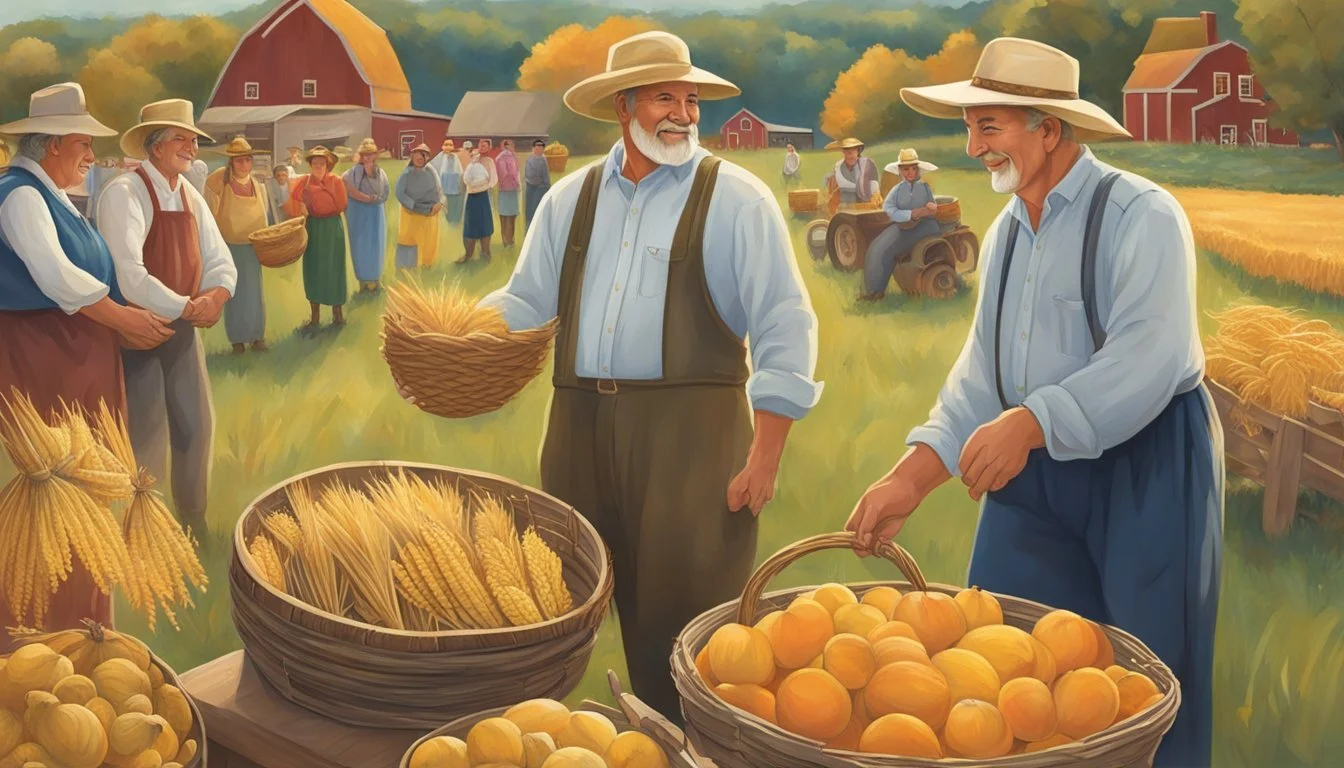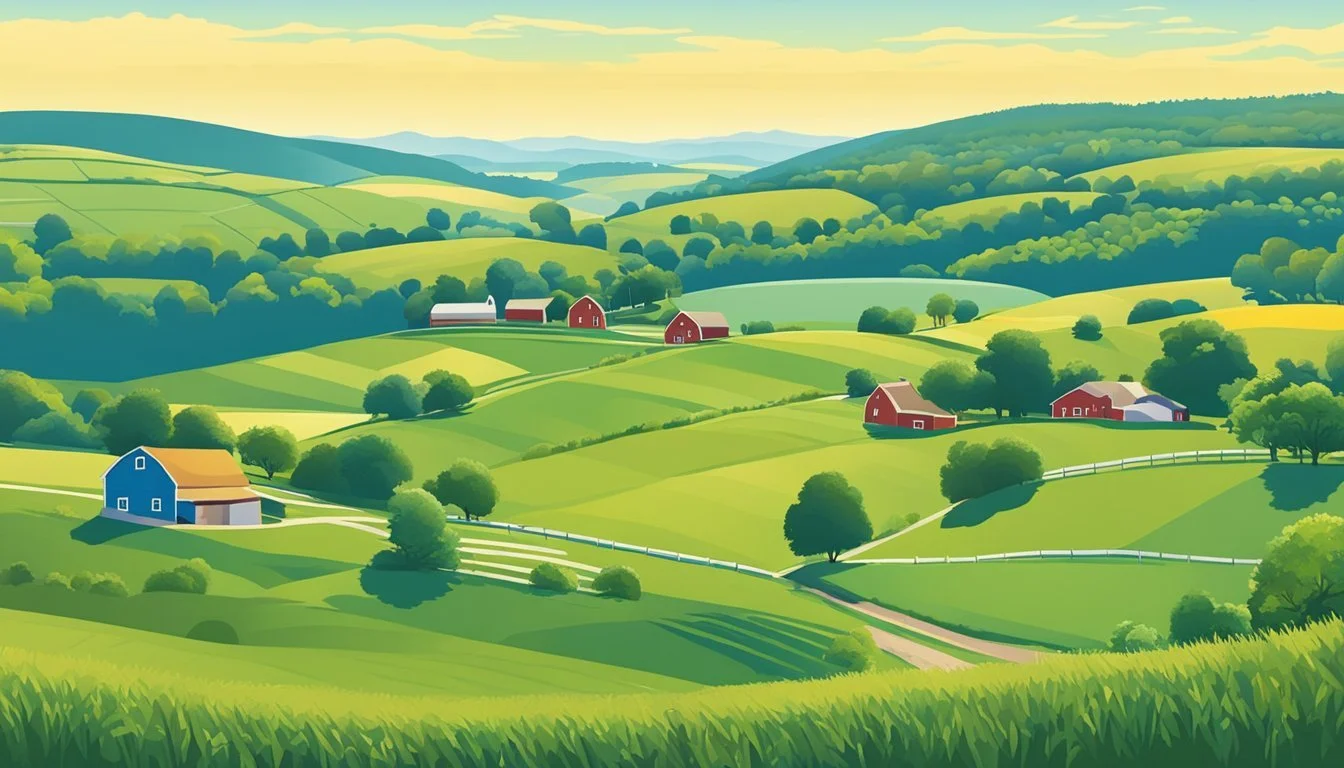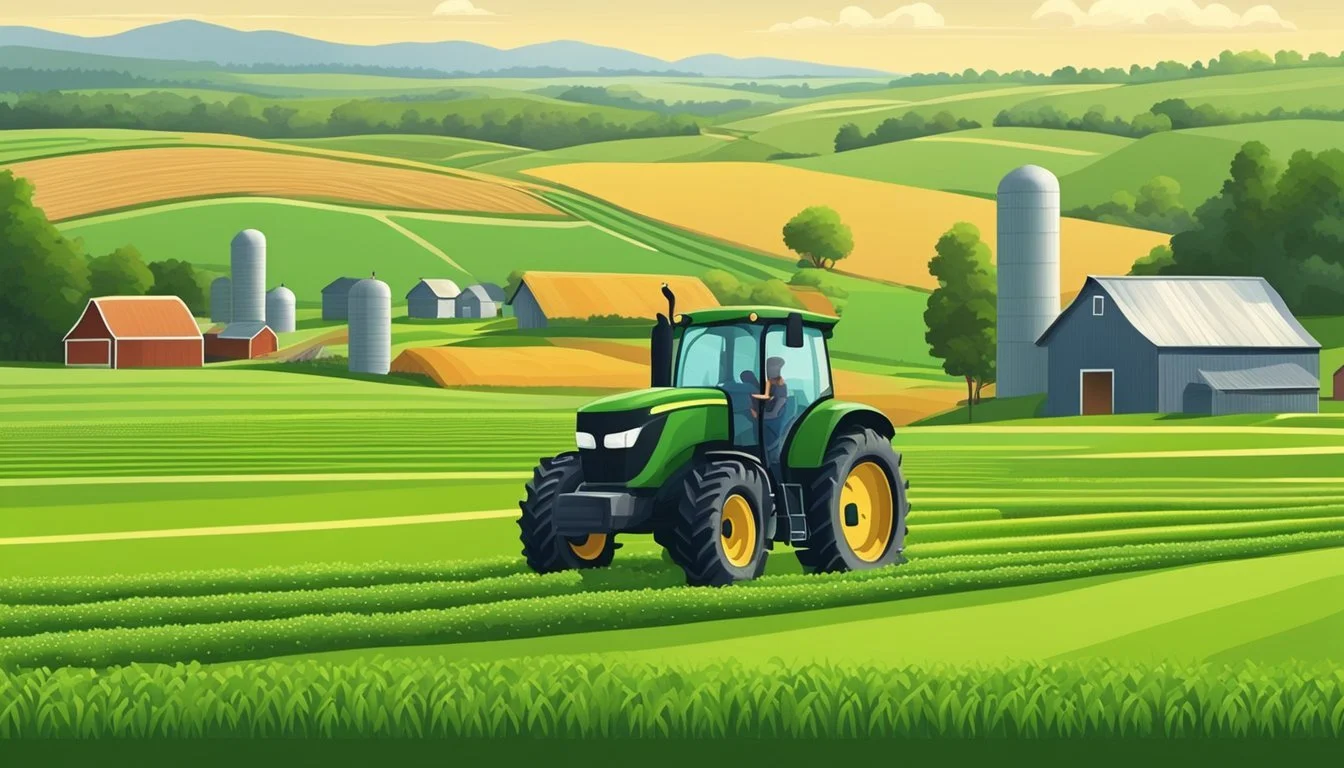Farming Communities in Connecticut
Sustainable Practices and Local Impact
Connecticut's farming communities offer a unique blend of history, modern agriculture, and vibrant rural life. From old farm houses on expansive acreage to small hobby farms, these communities demonstrate the state's rich agricultural heritage. With an average farm house price of $1,664,791 and land priced at approximately $150,643 per acre, Connecticut provides diverse opportunities for farming ventures.
Among Connecticut's farming communities, one finds both historic plantation homes and modern farmhouses, each contributing to the state's diverse agricultural landscape. The availability of properties ranging from small stone farmhouses to large commercial farms highlights the variety in size and function. Small farms, which average $712,533 per listing, are ideal for those interested in country living and raising livestock like goats, sheep, or poultry.
The communal aspect of farming in Connecticut is strengthened by organizations such as Connecticut FarmLink, which connects farmers with available land. With properties like the 280-acre farm in Windsor, which has been farmed for generations, the state showcases a tradition of agricultural excellence that dates back decades. This blend of historical richness and modern-day farming practices makes Connecticut's farming communities distinctive and compelling for prospective farmers and rural enthusiasts alike.
History of Farming in Connecticut
Connecticut's agricultural history is rich with diverse practices and has been shaped by various communities, including indigenous people and European settlers. From the development of 19th-century farming techniques to the prominence of tobacco farming in the Connecticut River Valley, the state's farming legacy is significant.
19th Century Agricultural Development
During the 19th century, Connecticut farmers adapted to changing economic and environmental conditions. Innovations in farming techniques and equipment improved productivity.
Small family farms were common, often growing a mix of crops and raising livestock. The Connecticut Society for the Promotion of Agriculture, established in 1794, played a crucial role in sharing farming knowledge and encouraging best practices.
Immigrants, particularly from Europe, contributed significantly to the agricultural diversity and labor force. By the late 1800s, farming was evolving to meet the demands of a growing industrial economy, leading to more specialized and commercial agricultural practices.
Tobacco Farming in the Connecticut River Valley
The Connecticut River Valley is renowned for its fertile soil, making it an ideal location for agriculture, especially tobacco farming.
Starting in the 19th century, Connecticut became a leading producer of high-quality tobacco. The valley's microclimates were particularly suited for growing Shade Tobacco, used as wrappers for cigars.
Farmers in the region developed sophisticated techniques to cultivate and cure tobacco, creating a thriving industry. This specialization attracted workers, including many immigrants, and significantly contributed to the state's economy. The legacy of tobacco farming remains a notable chapter in Connecticut's agricultural history.
Current State of Connecticut Farming
Connecticut's farming communities are adapting to both opportunities and challenges in a sector characterized by a rich variety of crops and livestock. Climate change and evolving economic pressures shape their daily realities.
Overview of Farming Communities
Connecticut hosts over 5,500 farms on more than 381,000 acres of land. The farming population consists of a mix of small family-owned operations and larger commercial enterprises. Community-supported agriculture (CSA) programs and local farmers' markets play an essential role in connecting farmers directly with consumers, allowing for the sale of fresh produce, dairy, and meat products. A blend of traditional and innovative farming techniques is evident, ensuring the sector's resilience and sustainability.
Dairy and Livestock Farming
Dairy farming remains pivotal, contributing significantly to Connecticut's agricultural economy. The state supports approximately 100 dairy farms producing milk and other dairy products. Livestock farming, including cattle, poultry, and egg production, complements dairy operations. Farmers face challenges related to fluctuating feed costs and climate conditions, but technological advancements and efficient farm management practices help maintain productivity.
Crop Production and Specialty Farms
Connecticut's crop production includes a mix of vegetables, fruits, and specialty crops. The state is known for its diverse produce, from apples and blueberries to specialty herbs and hops. Small-scale specialty farms grow organic vegetables and heirloom varieties, catering to niche markets. Farmers often use sustainable and organic practices, focusing on soil health, water conservation, and pesticide reduction to ensure high-quality yields.
Economic Impact and Business Aspects
Connecticut's agricultural sector significantly influences the state's economy through diverse product offerings and robust local markets. The industry's strategic integration with both traditional and modern business practices supports economic growth and sustainability.
Local Markets and Products
Connecticut's farmers benefit from strong local markets, where fresh, locally-grown products are sold directly to consumers. Farmers markets are vital, offering a variety of products, including dairy, floriculture, and miscellaneous crops. These markets help farmers maximize profit margins and foster community connections.
Online platforms have also become integral for marketing and sales. Many farms use e-commerce to reach a broader consumer base, facilitating year-round sales. Access to capital is crucial, with state funds and grants available to support farm startups, expansions, and sustainable practices, further influencing the economy positively.
Socio-Cultural Influence
Farming communities in Connecticut are deeply connected to socio-cultural aspects, including educational institutions, diverse representation among farmers, and active community engagements. These facets shape the agricultural landscape and influence the cultural fabric of the state.
Agricultural Education and Universities
Educational institutions play a crucial role. The UConn Extension Program offers comprehensive support to farmers through workshops, research, and on-field assistance.
Agricultural education is also enriched by programs at UConn's College of Agriculture, Health, and Natural Resources (CAHNR). Courses and hands-on training help future farmers develop sustainable practices and innovative agricultural techniques. The integration of academic research with local farming practices fosters a knowledgeable community committed to agricultural excellence. Students often engage directly with farming activities, bridging theoretical knowledge with real-world application.
Diversity and Representation in Farm Ownership
Connecticut's farming community is diverse. BIPOC farmers are increasingly gaining recognition and support, ensuring equitable representation in the agricultural sector.
Programs focusing on minority farmers provide resources and assistance, promoting inclusivity. The historical presence of Jewish farmers in Connecticut, highlighted in the work "A Life of the Land: Connecticut’s Jewish Farmers," underscores the long-standing diversity in the region. Efforts to support minority-owned farms include grants, training, and market access programs, aimed at fostering an inclusive environment where every farmer can thrive.
Community Engagement and Agriculture
Community involvement is integral. Initiatives like Grown Connected by UConn CAHNR nurture connections between farmers and local residents through events, blogs, and community-supported agriculture (CSA) programs.
Urban farmers, such as those in Hartford's South End, contribute significantly by providing fresh produce and engaging in educational outreach. Community farms serve as hubs for local interaction, offering volunteering opportunities and hosting community events. Such engagements help build trust and cooperation, reinforcing the importance of agriculture in the social and cultural life of Connecticut.
These combined efforts ensure that farming remains a vital and vibrant part of Connecticut's socio-cultural landscape.
Agricultural Techniques and Infrastructure
Connecticut's farming communities are integrating modern practices and sustainable methods to enhance productivity and environmental health. Urban farming initiatives are also expanding, addressing local food security and offering innovative solutions.
Modern Farming Practices
Farmers in Connecticut are adopting advanced technologies to increase efficiency and yield. Precision agriculture techniques, such as GPS-guided equipment and drone monitoring, optimize planting, fertilization, and irrigation.
Hydroponics and aquaponics are becoming more common, allowing growth without soil and combining fish farming with plant cultivation. This reduces space and resource usage while maintaining high productivity. Greenhouses equipped with automated climate controls extend growing seasons and protect crops from adverse weather conditions.
Sustainable Farming and Environmental Responsibility
Many Connecticut farmers emphasize sustainability and environmental responsibility. Crop rotation and cover cropping improve soil health and reduce erosion. Integrated Pest Management (IPM) minimizes chemical use by employing natural predators and organic solutions.
Renewable energy, like solar panels, powers farm infrastructure, lowering carbon footprints. Conservation tillage methods decrease soil disturbance, promoting biodiversity and water retention. Composting and manure management recycle nutrients back into the soil, further enhancing sustainability.
Urban Farming Initiatives
Urban farming is growing rapidly in Connecticut’s cities. Programs like the Keney Park Sustainability Project in Hartford are pivotal. They provide training in sustainable practices and access to fresh produce.
Innovative projects include rooftop gardens, community gardens, and hydroponic setups, often operated by local volunteers using minimal space and resources. These urban farms combat food insecurity by supplying fresh, locally grown vegetables and fruits to underserved areas. They also foster a sense of community and provide educational opportunities on sustainable agriculture.
Regional Diversity in Farming
Connecticut's farming communities exhibit a rich tapestry of regional diversity, shaped by factors such as geography, urban proximity, and historical land use. These elements collectively influence both the types of agriculture practiced and the demographics of the farmers involved.
Farming in Eastern Connecticut
Eastern Connecticut features vast expanses ideal for agriculture. Towns like Norwich and Lebanon are key agricultural hubs. The region benefits from fertile soil, making it suitable for crops such as dairy, vegetables, and tobacco.
Norwich is known for its small farms that specialize in organic produce. Lebanon plays a significant role in dairy farming and hosts numerous family-run farms. Support from local organizations, like the Farm Bureau, empowers farmers by providing resources and advocacy.
Agriculture Near Major Urban Centers
Agricultural activities near urban centers like New York City and New London are characterized by smaller, more intensive farming operations. These urban farms provide fresh produce to local markets and often employ innovative techniques like vertical farming and hydroponics.
New London has seen a rise in community-supported agriculture (CSA) initiatives, connecting residents with local growers. Proximity to New York City opens substantial market opportunities for fresh and organic produce, driving economic sustainability for small farms within commute distance.
Distinct Characteristics of Rural Communities
Rural communities such as Ellington differ significantly from their urban counterparts. These areas often feature larger plots of land, which support more extensive agricultural operations, including livestock and large-scale crop production.
In Ellington, farming is a key part of the local identity, with generational farms dominating the landscape. The sense of community and shared tradition among farmers strengthens local agricultural practices. These rural areas often prioritize sustainability and conservation, fostered by programs aimed at preserving farmland and supporting farmers.
Together, these regions illustrate the varied nature of Connecticut's farming landscape, highlighting how location-specific factors shape agricultural practices and community dynamics.
Connecticut’s Farming Future
Connecticut's agricultural sector is navigating a complex landscape, marked by evolving challenges and innovative opportunities. Local farmers are finding ways to adapt, while issues around land access and ownership remain critical.
Challenges and Opportunities
Connecticut's farming industry faces significant challenges due to climate change, impacting crop yields and farm sustainability. Farmers like Jon Hermonot have noted dramatic shifts between dry and wet conditions. This variability complicates farming practices and increases operational costs.
Economic pressures also pose challenges. Small farms struggle with profitability amid rising costs for labor, equipment, and technology.
Yet, opportunities arise from a growing local food movement. Farmers' markets and community-supported agriculture (CSA) programs enable direct-to-consumer sales, boosting farm income.
Innovation and Adaptation
Connecticut's farmers are leveraging technology and innovation to overcome challenges. Advanced irrigation techniques and climate-resilient crops help mitigate the effects of weather extremes. Farmers adopt precision agriculture technologies to optimize resource use and enhance productivity.
Sustainable practices are gaining traction. Organic farming, agroforestry, and regenerative agriculture are being embraced to promote long-term soil health and biodiversity. Urban farming initiatives are also growing, offering fresh produce in densely populated areas and reducing food deserts.
Land Access and Ownership
Access to land remains a significant hurdle for new and young farmers in Connecticut. Rising land prices make it difficult for aspiring farmers to acquire or lease land. The New CT Farmer Alliance works to address these issues by connecting farmers with resources and opportunities.
Equity in land ownership is also critical. Programs aimed at supporting minority and disadvantaged farmers are essential to fostering a diverse agricultural community. Policy initiatives that protect farmland from development are crucial to maintaining the agricultural landscape.
Community-supported land trusts and agricultural easements provide innovative solutions for preserving farmland and ensuring it remains accessible to future generations.
Practical Information for Visitors and Residents
Connecticut offers numerous opportunities to explore its vibrant farming communities, whether you are planning a visit or engaging with local programs. Discover local farms, shop at farmers markets, and participate in community events that support agriculture.
Visiting Local Farms
Visiting local farms in Connecticut offers a fascinating insight into the state's agricultural heritage. Many farms such as Flamig Farm in Simsbury and Thorncrest Farm in Goshen provide guided tours, workshops, and hands-on activities.
At Flamig Farm, visitors can meet and feed various farm animals, and tour the grounds. Thorncrest Farm offers cheese-making classes where participants can learn to make mozzarella, ricotta, and other cheeses. White Gate Farms in East Lyme welcomes visitors to participate in organic gardening sessions and to collect fresh eggs.
Most farms have specific hours for visitors and provide updated information on their websites and social media pages. It's advisable to check these hours before planning your visit to ensure availability and any special events or workshops happening on that day.
Community Programs and Events
Connecticut's farming communities regularly host programs and events to foster community spirit and support local agriculture. One notable initiative is Grown Connected, launched by UConn's Extension Program in Tolland. This program brings together local farmers and residents, promoting agricultural practices and communal activities.
Farmers markets are popular venues for purchasing fresh produce and artisanal goods directly from growers. These markets often feature live music, children's activities, and seasonal festivals. Check local listings or community boards for the latest market hours, locations, and special events.
Social media channels and official websites frequently update residents and visitors on upcoming community events. Engage with these platforms to stay informed about opportunities to participate in Connecticut's rich agricultural traditions.









